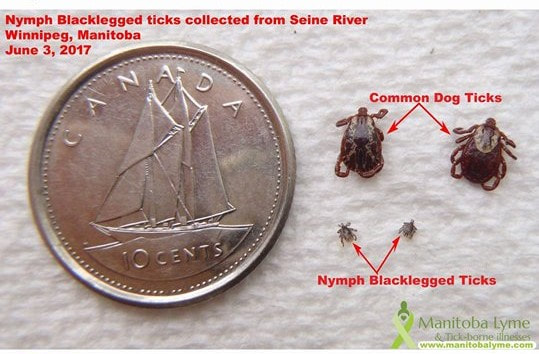|
Why is Lyme Disease Spreading across Manitoba (and Canada?)
* Share and spread awareness * Ticks have 4 stages to their life cycle. Larvae will hatch from the egg and will seek its first host in order to obtain a blood meal. Their first host is generally a small rodent, such as mice or squirrels, or birds. Once they are fed, they molt into their next life stage - nymphs. Nymphs are very tiny, about the size of a poppy seed. To get perspective, if you look at a dime, the nymph deer tick will fit in the “0” in the “10 cents” writing. Nymphs are active right now, and this is the time to be aware as they are very hard to see. On a human, they may look like a freckle. The blacklegged nymphs featured on our most recent surveillance photo were found along the Seine River June 3. Many of us are familiar with the more common dog ticks, but as our photo shows these nymph deer ticks are so much smaller. When a host animal is already infected with the bacteria for Lyme or other tick-borne illnesses, (anaplasmosis and babesia) any feeding blacklegged tick will also be infected with the same bacteria. When it drops and morphs into the next life cycle, it will then infect the next host (along with any other ticks that are currently attached or will attach in the future). This is why Lyme Disease is spreading so rapidly across our country. It is estimated that by 2020 over 80% of Canada will have the blacklegged ticks. Manitoba Health’s Tick-borne Disease report indicates that June is the peak month for receiving a Lyme diagnosis. It is still very important to take necessary precautions to prevent tick bites – use repellent containing at least 20% deet or icardin, do proper tick checks, and be aware of symptoms. If you have been bitten by a tick, or are unsure but have unexplained flu-like symptoms, it is important to see a doctor immediately. Remember, a bulls-eye rash only appears about 40% of the time, but does indicate a Lyme infection. Lyme disease is a very manipulative bacteria that can cause life-long symptoms, so early treatment is essential for a full recovery. To assist your doctor with your treatment, we recommend downloading the most recent physician information and take it to the appointment with you. (link is provided below) Physician’s update regarding tick-borne illnesses: http://www.gov.mb.ca/…/publich…/cdc/docs/hcp/2017/040717.pdf Manitoba Tickborne Illness Report: http://www.gov.mb.ca/…/cdc/tickborne/docs/tbd_report2015.pdf Manitoba Health Lyme Disease Information: http://www.gov.mb.ca/health/publichealth/diseases/lyme.html Removing a Tick https://www.facebook.com/ManitobaLyme/photos/a.324159074609810.1073741829.243648385994213/419162281776155/?type=3&theater Preventing a Tick Bite https://www.facebook.com/ManitobaLyme/photos/a.331293610563023.1073741830.243648385994213/425779504447766/?type=3&theater Comments are closed.
|
Janet Lewis Anderson
Hi everyone. As most of you know, I am your Webmaster. Welcome to our Blog Page. Archives
September 2021
Categories |
|
Contact Us:
CN Pensioners Association of Manitoba 10 Greenwich Bay Winnipeg, Manitoba R2J 1T6 Email: [email protected] |


 RSS Feed
RSS Feed